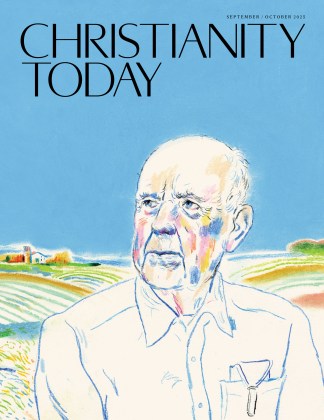 Update: Disaffiliations approved by UMC conferences now total more than 5,800 churches as of June 16, 2023.
Update: Disaffiliations approved by UMC conferences now total more than 5,800 churches as of June 16, 2023.Nearly four years ago, the United Methodist Church approved an exit plan for churches wishing to break away from the global denomination over differing beliefs about sexuality, setting in motion what many believed would be a modern-day schism.
Since then, a new analysis has found, it’s fallen well short of that.
That analysis of data collected by the church’s General Council on Finance and Administration shows 6.1 percent of United Methodist churches in the US—1,831 congregations out of 30,000 nationwide—have been granted permission to disaffiliate since 2019. There are no good figures for international departures among the estimated 12,000 United Methodist churches abroad.
The denomination’s disaffiliation plan gives churches until December 31 to cut ties, and many have already made known their desire to leave. Those churches can take their properties with them after paying apportionments and pension liabilities. Others are forcing the issue through civil courts.
But whatever the final tally may be, the analysis suggests the country’s second-largest Protestant denomination—numbering 6.4 million US members and 13 million worldwide—may weaken but is unlikely to break.
“You think of a schism as 50 percent or even 35 percent (split),” said Scott Thumma, director of the Hartford Institute for Religion Research and a lead researcher for the 2020 US Religion Census. “This is not a real schism.”
The 1,831 church departures come as United Methodist bishops say they’re battling misinformation from conservative groups that encourage churches to leave the denomination for the newly formed Global Methodist Church, which has declared it will never ordain or marry LGBTQ people—the crux of the conflict.
In turn, the Global Methodist Church and groups like the Wesleyan Covenant Association, a network of theologically conservative churches, argue that the denomination’s regional conferences are making it prohibitively hard for churches to leave.
The high-stakes duel has hit some regions of the country harder than others. But four years into what has been depicted as a breakup of the denomination, the picture is less climactic than anticipated.
“Some are leaving but the number of churches and members moving forward is far larger,” said Hope Morgan Ward, retired bishop of the North Carolina conference. “It is important to focus on who is staying and moving forward in the continuing United Methodist Church.”
The past year has brought “mixed emotions,” according to Bishop Thomas Bickerton of the New York Annual Conference, who leads the United Methodist Church’s Council of Bishops. Bickerton described it as a “period of disunity.”
In March 2022, the United Methodist Church announced a third delay for the 2020 meeting of its global decision-making body, the General Conference. Delegates were expected to consider a proposal to split the church in 2020. Then came the COVID-19 pandemic.
The final delay prompted some Methodists to go ahead in May and launch the Global Methodist Church rather than wait for the outcome of a General Conference meeting.
In the meantime, the denomination’s 54 US-based regional bodies called conferences have been approving disaffiliations at their regular meetings and at a flurry of special sessions.
https://datawrapper.dwcdn.net/hnZi8
The Texas Annual Conference, a region that covers East Texas with headquarters in Houston, lost 302 of its nearly 600 churches—the most of any conference, the analysis reveals.
Analysis of the denomination’s data shows the largest number of churches choosing to leave are located in the Southeastern and South Central US
The five conferences with the greatest number of exiting churches are in Texas, North Carolina, Alabama, and Indiana. These five conferences, with two in Texas, account for 57 percent of all departures. Contrast that with Bickerton’s own New York conference, where no churches have left yet, though six are discussing it, according to the bishop.
The Southeastern and South Central conferences tend to be more conservative and evangelical in their beliefs, said Will Willimon, a retired United Methodist bishop and a professor of the practice of Christian ministry at Duke Divinity School. Politically, they vote Republican and are far more resistant to gay rights.
“Those wishing to disaffiliate will deny that, but to me it’s another instance of how the Methodist movement has a long history of being very influenced by secular worldly political matters,” Willimon said.
The United Methodist conflict is just the latest upheaval over sexuality for Protestant denominations in the United States.
Hundreds of churches left the Episcopal Church after it elected its first gay bishop in 2003. They formed the Anglican Church in North America, which now has nearly 1,000 churches. Likewise, a change allowing same-sex marriage in the Presbyterian Church USA’s constitution led many congregations to break away.
The Rev. Keith Boyette, who heads the Global Methodist Church as its transitional connectional officer, said views on sexuality are only one reason churches leave.
“I believe, for many of the churches, that’s just been a presenting issue, and that the reasons why they want to leave are much more significant,” he said. “Some have grown weary of the never-ending conflict.”
Bickerton doesn’t disagree.
“Our provision that allows for disaffiliation is based on a church reaching the conviction that they can’t stay a part of the denomination over matters of human sexuality,” said Bickerton, president of the Council of Bishops. “What we find is that people are using that paragraph to disaffiliate for other reasons.”
Some don’t want to be part of organized religion or don’t like the denomination’s apportionment system or aren’t happy with their current pastor or disagree with the actions of their bishop—or a leader in another part of the country or world, according to the bishop.
The result has been a messy disaffiliation process in some conferences.
Some churches have taken to suing conferences to be allowed to leave immediately, including 38 churches in the Western North Carolina Annual Conference.
The Wesleyan Covenant Association has called on its network of churches to withhold apportionments, or pooled giving, to those conferences it believes are making it more difficult for congregations to leave.
And in recent weeks, the bishop of North Georgia Annual Conference announced she was temporarily blocking any of its churches from leaving the denomination, citing the spread of “defamatory” misinformation.
In addition, it now appears not all exiting churches are joining the newly formed Global Methodist Church.
Only 1,100 churches have joined the Global Methodist Church since it launched in May—98 percent of them located in the US—according to a recent announcement from the new denomination. That means the new denomination has absorbed 58 percent of departing United Methodist churches in the US
White’s Chapel near Fort Worth, Texas—one of the largest United Methodist churches in the US, with a membership of 16,000—disaffiliated last year, saying it hopes to create its own network of like-minded Methodist churches.
Frazer Memorial, a church of 4,000 members in Montgomery, Alabama, opted to join a smaller denomination known as the Free Methodist Church.
And the The Woodlands, a church of about 14,000 members north of Houston, has yet to decide if it wants to affiliate with the Global Methodist Church.
The Rev. Rob Renfroe who recently retired as a pastor of The Woodlands said he believes the Lonestar State is leading in disaffiliations, in part, because it’s simply easier to do so there.
“What we’re finding in Texas is that, where there is a fair and open process for disaffiliation, that many churches are doing so,” said Renfroe, the president of Good News, a theologically conservative advocacy group within the United Methodist Church.
But Boyette argues the numbers joining the new denomination are “close to being miraculous” given what he said is a costly and cumbersome process in many annual conferences.
“I believe that the powers that be in the United Methodist Church have been surprised by the number of churches that desire to disaffiliate in some annual conferences,” Boyette said.
This conflict over sexuality coincides with an ongoing decline in membership within the denomination.
The United Methodist Church dropped from 7.7 million members to 6.4 million in the US over the past decade, a loss of 1.3 million members. The average age of its members is 57. And it is closing more churches than starting new ones. The effect of the split will add to those losses.
The 1,831 disaffiliating churches may ultimately include up to 400,000 members (though departing churches are unlikely to bring all their members along; some may switch to another United Methodist church). The denomination will also lose an estimated million in annual contributions to the denomination—about 5.5 percent of the denomination’s pooled giving.
Bickerton said the losses aren’t just financial.
The denomination also is losing voices and perspectives he believes are important, though he is resigned to the fact that some churches will choose to leave. United Methodists must bless them as they depart, he said.“I would always say to people that when we’re together, we’re a better reflection of Jesus than any of us are by ourselves, which is to say that we need that divergent thought,” Bickerton said. “We need conservatives and liberals and moderates in order to be the body of Christ that we proclaim to be.”
History is a great place to go to test “slippery slope” arguments ? claims that “Questionable Belief or Practice A” will inevitably lead us to “Horrifying Situation B.” One way to answer the argument is to appeal to precedent: “Let’s look back and see whether things like ‘A’ have led to situations like ‘B’ in the past.”
These days evangelicals with a heart for (1) ecumenical dialogue, (2) liberal education, and (3) cultural engagement are being told by fundamentalist watchdogs that they are leading good, faithful, Bible-believing people straight down the road to “liberalism.”
Let’s put this to a historical test.
Our focus: a small, persecuted, pietistic sect to which “father of modern education” and Protestant bishop John Comenius belonged in the 1600s.
This was the Unity of the Brethren, which descended from the pre-Reformation reformer Jan Hus. At a key point in their history, this pietistic Protestant group, exiled from its own lands (Bohemia and Moravia) during the Thirty Years War, made a decision NOT to pull in its horns and retreat into a culturally marginal fundamentalism. It decided instead to engage the culture around it.
It was this single decision more than any other that allowed Comenius to forge a highly effective Europe-wide program of Christian-based, ecumenical education that earned him the title “Father of Modern Education.”
Comenius’s educational plan transformed the way children were schooled, created an ecumenical vision for scholarship that inspired Britain’s Royal Society (which fostered “fathers of modern science” like Isaac Newton), and today is honored by a pan-European educational initiative that is named after Comenius.
Comenius believed that we are often involved in strife with groups culturally unlike us because we have not been educated to understand one another. He understood that lack of education as part of a larger pattern of sinfulness. And he integrated into that educational vision a priority for godliness and a distinctively Christian morality. Essentially, he brought Europe a new and effective plan for Christian liberal education, from cradle to graduate school.
Comenius’s Christian vision broke through what we might call “the Scandal of Confessional Education” that had contributed to the Thirty Years War, and contributed to the tolerant denominationalism that followed the Westphalian Settlement.
Now, in response to the fundamentalist “slippery slope” argument: To create this vision of Christian education, Comenius had to turn away from any bitterness he felt at his small sect’s persecution and exile during the religious wars that marred his youth. He had to find the resources turn to his persecutors in Christian love and show them a better way. Where did he find the courage and vision for this?
In my forthcoming book Patron Saints for Postmoderns (IVP, September 2009), I conclude a chapter on Comenius with these words:
The second paradox of Comenius’s life lies in reaction to the slaughter and exile of his small, fringe Christian community by others bearing the name ‘Christian.’ This sectarian leader certainly could have done what so many others persecuted Christians have done: retreated in rage and bitterness, licked his wounds with his people, and set up legalistic fences to keep outsiders out. Instead, he insisted on the ecumenical slogan: ‘In essentials, unity; in non-essentials, liberty; in all things, charity.’ And he poured his life out for church unity and international peace.
Before his often tragic life was done, John Amos Comenius created a breathtaking vision of international peace and cooperation. At the heart of this vision was a comprehensive educational program that already, in his lifetime, began to transform the way Europe’s children were taught. We have asked how Comenius could possibly do this, given his background in a small persecuted group who were hounded, killed, and exiled by fellow Christians. It seems a paradox that a persecuted, pietistic sect could form a person such as this!
The key to this paradox seems to be something that had happened to the Unity of the Brethren by the early sixteenth century. Now flourishing and increasingly influential, the Brethren were forced to confront the perennial question of the relationship between Christ and culture. Many devout Christians believe growth and cultural power cannot happen without compromising the radical nature of the gospel. The church must, such folks argue, forgo all attempts to ‘transform culture,’ for such attempts inevitably suck the life out of the church. Was this the case with the Unity and Comenius?
Certainly in the decades of their peasant origins, the Brethren had distrusted all people of other classes and all trappings of culture. But as a new diversity of folks – even nobles such as Count Zerotin – were drawn by these people’s strong devotion and joined with them, the group moderated its views. Inevitably, some Brethren felt this moderation as a betrayal. They pushed the group to ‘hold up its ancient standard’ of enmity against all structures of worldly culture. But this group of world-renouncing conservatives did not win the day. Instead, a schism occurred, with the majority taking the progressive (though still theologically conservative and experientially pietistic) position.
? [H]ad this social widening not occurred among the Brethren, Comenius would likely never have developed his unique mix of deep piety and broad (‘liberal’) culture. Nor, very likely, would the European Union today be acknowledging Comenius as its teacher in this matter of international liberal education. But in fact, it is doing so: the European Commission of the EU has created a government-supported, pan-European elementary education initiative ?, named ‘Comenius’ after the Brethren bishop and educator. The program promotes the same values that drove its namesake’s reforms of the 1600s: pedagogical innovation, transnational cooperation, and equal opportunity for all students. Comenius, and his Lord, seem still to be at work.
Now, fundamentalist watchdogs of today who would look back at that key moment when the Unity decided not to go in a fundamentalist direction would doubtless trot out a “slippery slope” argument: “Any denomination that went in this liberal, culture-engaging direction could not last as an evangelical, pietist denomination. It would become liberal in theology and disappear from history as an effective gospel witness.”
So it’s worth asking: What did happen to the Unity of the Brethren?
Answer: the ragged, exiled remnant of this group showed up on Count Ludwig von Zinzendorf’s doorstep in the mid-1700s. Initially they found themselves not getting along at all with the other religious exiles at Zinzendorf’s estate. But through a kind of “Pentecost experience,” they joined with the German pietists and other exiles and formed the Moravian Church.
Was this a liberal denomination that sold out the gospel? Hardly. They started a 100-year round-the-clock prayer meeting, sent missionaries all over the world, and inspired John Wesley, who birthed evangelicalism in England. They did all of this while maintaining a strong ecumenical testimony. Zinzendorf used to talk about the many Protestant denominations as “facets of a gem.”
The Moravians, anything but theologically liberal, held to the dictum Comenius’s Brethren had espoused: “In essentials unity, in non-essentials liberty, and in all things charity.” And yet they believed and practiced an evangelical orthodox faith that affirmed Reformation essentials such as Justification by Faith and Sola Scriptura, and preached the need to be born again.
Engaging culture and opening the ecumenical windows are closely-related enterprises. Both require an openness to higher education and a desire to see our sons and daughters educated in a “liberal” mode – meaning not theologically liberal, but open to “all knowledge as God’s knowledge,” and seeking understanding across the boundaries that separate people and even drive them to violence.
Again, the heirs of the fundamentalists are criticizing evangelicals more and more for “selling the farm” theologically because they stick firmly to both an agenda of cultural engagement and an openness to finding true Christians within a broad array of denominations and churches – perhaps even among the Roman Catholics and Eastern Orthodox.
Such critics tell us that by such openness we will cut ourselves off from essential truths of the gospel and cease being effective for God’s kingdom. Comenius’s Brethren and Zinzendorf’s Moravianism – two key genetic precursors of the evangelicalism that nurtured these very same modern fundamentalists – are proof that this critique is false.
And when we get to John Wesley, one of the two “fathers of evangelicalism,” we see him furthering this same impulse. As he said in one famous sermon: “If your heart be as mine, then give me your hand.”
A subtext of this fundamentalist critique: any attempt at liberal education will inevitably work against the gospel.
If this is true, then isn’t it odd that Oxford-trained John Wesley could pick up the ecumenical, evangelical pietist vision, which had its roots in Comenius’s vision of a liberal, educated, culture-engaged pietism, and start the most significant religious revival in modern history?
Did John Amos Comenius put us on a slippery slope?
Yeah, right down into evangelicalism.
* * *
Related elsewhere:
Bethel University recently convened a conference on pietism. Read about it here and here.
Jan Amos Comenius was the featured topic of Christian History Issue 13. Find an index of online articles here. To purchase copies of Issue 13, click here.
* * *
Public domain image of J.A. Comenius via Wikimedia Commons and taken from Aug. Schorn and Herm. Reinecke, Pedagogikens historia (1895)








